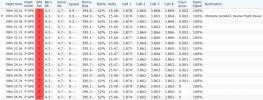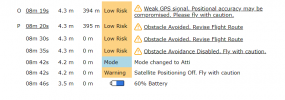- Joined
- Sep 13, 2018
- Messages
- 42
- Reactions
- 0
- Age
- 58
Hello,
I would appreciate if anyone could help me get a better understanding of what I did wrong that caused a crash of my Mavic 2 Pro on the balcony where I was trying to land it. I was maneuvering the drone towards the balcony, when, at about a couple of meters of distance, it stopped its forward motion and started hovering without responding to my input command to move closer. In a previous occasion that I had experienced that, the drone was at arm's length, so I had just grabbed one of the plastic "feet" under the motors and moved it on top of the balcony floor This time it was not possible, so my reaction, attributing the refusal to proceed forward to some conservative judgment of the obstacle detection algorithm, was to disable it and then move carefully the drone towards me. However, what happened was totally unexpected by me: as soon as I disabled the obstace detection system, the drone stopped hovering and started rapidly drifting diagonally towards the wall on its front left. The velocity of this drift and my complete surprise conjured to make my reaction useless to stop the drone before it hit first the wall and then the floor.
From the logs I see that as soon as I disabled obstacle detection, the drone entered ATTI mode, in which (from what I read) the drone is far less maneuverable, which would partially explain what happened, even if not completely as the suddenness and the speed with which drone moved seemed as if it was commanded in that direction. I have many questions, whether the switch to ATTI mode caused the crash, whether that mode switch is automatic when disabling obstacle detection or if some other factors played a role (like a weak GPS signal).
However besides the postcrash forensics, I think the main learning from me would be to understand the best way to maneuver the drone back to a home point located on a structure with the characteristics of a balcony, i.e., a space enclosed by a low front wall, a tall back wall and a ceiling but with an opening that is large enough for a safe entrance.
I am attaching a few log files into a zip for analysis, and the link to AirData. Please let me know whether additional info is needed.
Thanks
I would appreciate if anyone could help me get a better understanding of what I did wrong that caused a crash of my Mavic 2 Pro on the balcony where I was trying to land it. I was maneuvering the drone towards the balcony, when, at about a couple of meters of distance, it stopped its forward motion and started hovering without responding to my input command to move closer. In a previous occasion that I had experienced that, the drone was at arm's length, so I had just grabbed one of the plastic "feet" under the motors and moved it on top of the balcony floor This time it was not possible, so my reaction, attributing the refusal to proceed forward to some conservative judgment of the obstacle detection algorithm, was to disable it and then move carefully the drone towards me. However, what happened was totally unexpected by me: as soon as I disabled the obstace detection system, the drone stopped hovering and started rapidly drifting diagonally towards the wall on its front left. The velocity of this drift and my complete surprise conjured to make my reaction useless to stop the drone before it hit first the wall and then the floor.
From the logs I see that as soon as I disabled obstacle detection, the drone entered ATTI mode, in which (from what I read) the drone is far less maneuverable, which would partially explain what happened, even if not completely as the suddenness and the speed with which drone moved seemed as if it was commanded in that direction. I have many questions, whether the switch to ATTI mode caused the crash, whether that mode switch is automatic when disabling obstacle detection or if some other factors played a role (like a weak GPS signal).
However besides the postcrash forensics, I think the main learning from me would be to understand the best way to maneuver the drone back to a home point located on a structure with the characteristics of a balcony, i.e., a space enclosed by a low front wall, a tall back wall and a ceiling but with an opening that is large enough for a safe entrance.
I am attaching a few log files into a zip for analysis, and the link to AirData. Please let me know whether additional info is needed.
Thanks












